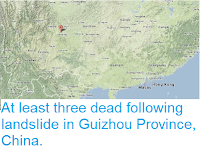Thirty six people have now been confirmed dead and a further fifteen are still missing following a landslide in Guizhou Province, China, on Tuesday 23 July 2019. Around 40 people have been rescued alive following the incident, in which over two million cubic meters of hillside collapsed onto a village in Shuicheng County following heavy rains. Landslides are a common problem after severe weather events, as excess
pore water pressure can overcome cohesion in soil and sediments,
allowing them to flow like liquids. Approximately 90% of all landslides
are caused by heavy rainfall.
Rescue workers in Shuicheng County, Guizhou Province, China, following a landslide on 23 July 2019 that buried 22 houses under two million cubic meters of rock and mud. Xinhua.
Central Guizhou has a warm temperate climate with high levels of
rainfall all year round. Rainfall is typically highest in June when the
area often receives over 200 mm of rainfall. July is drier, but
typically still has over 100 mm of rain. This year's summer has been
exceptionally wet, with a number of flooding incidents across the
province.
Rescue workers in Guizhou Province, China, following a landslide this week. AFP.
Guizhou Province is largely comprised of blocky limestone hills,
uplifted by the collision between India and Asia during the Tertiary
period. The area has a monsoonal climate, with heavy seasonal rains
which start in April, reach a peak in July and August, and tapir out in
October. Historically the hills were covered by subtropical broadleaved
forest, but, despite the area being considered to be a high conservation
priority with a number of highly protected species and internationally
recognised reserves, the province has been hit heavily by deforestation,
making it vulnerable to landslide events as soils are washed of the
underlying limestone karst.
See also...
Follow Sciency Thoughts on Facebook.








